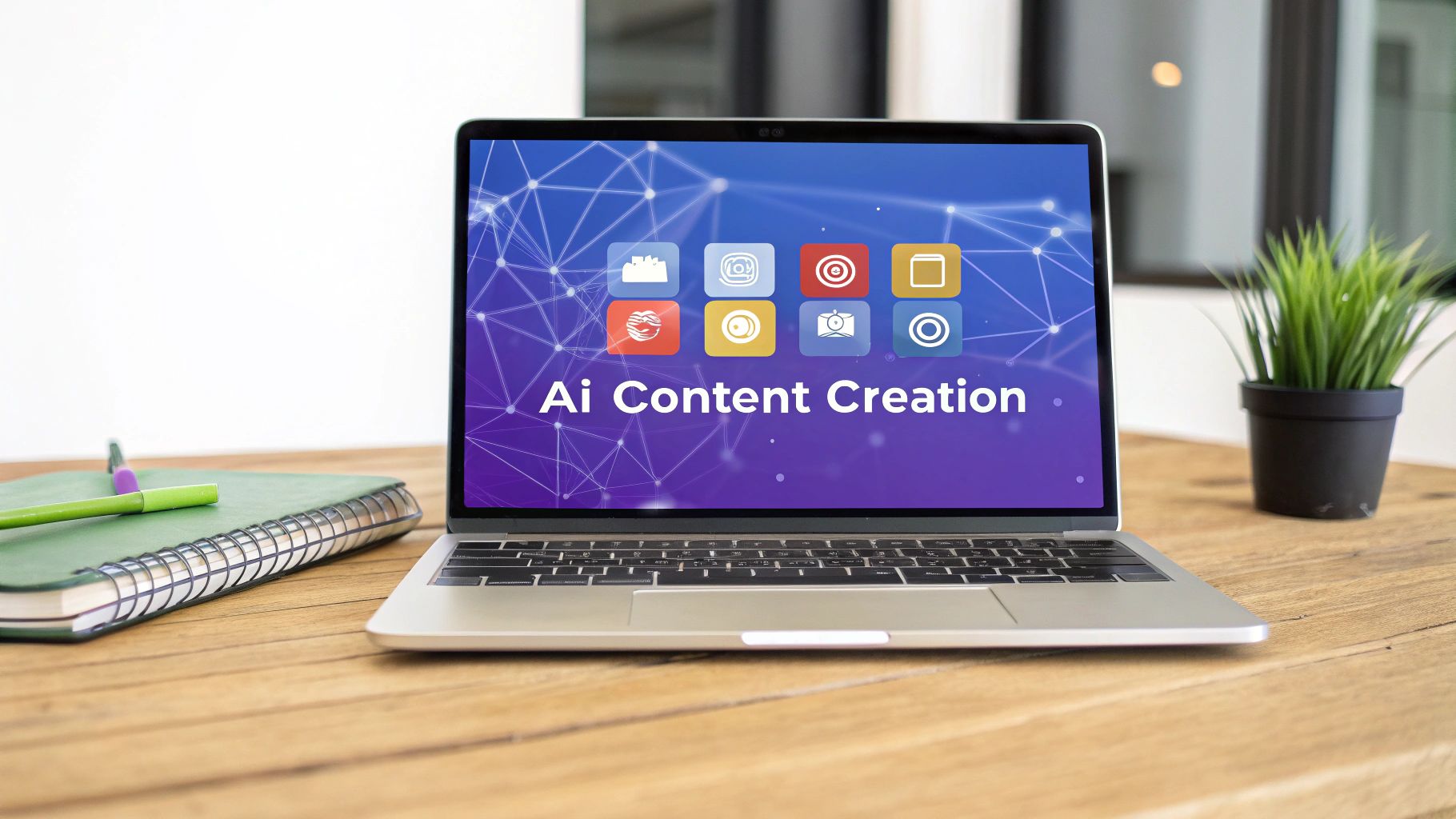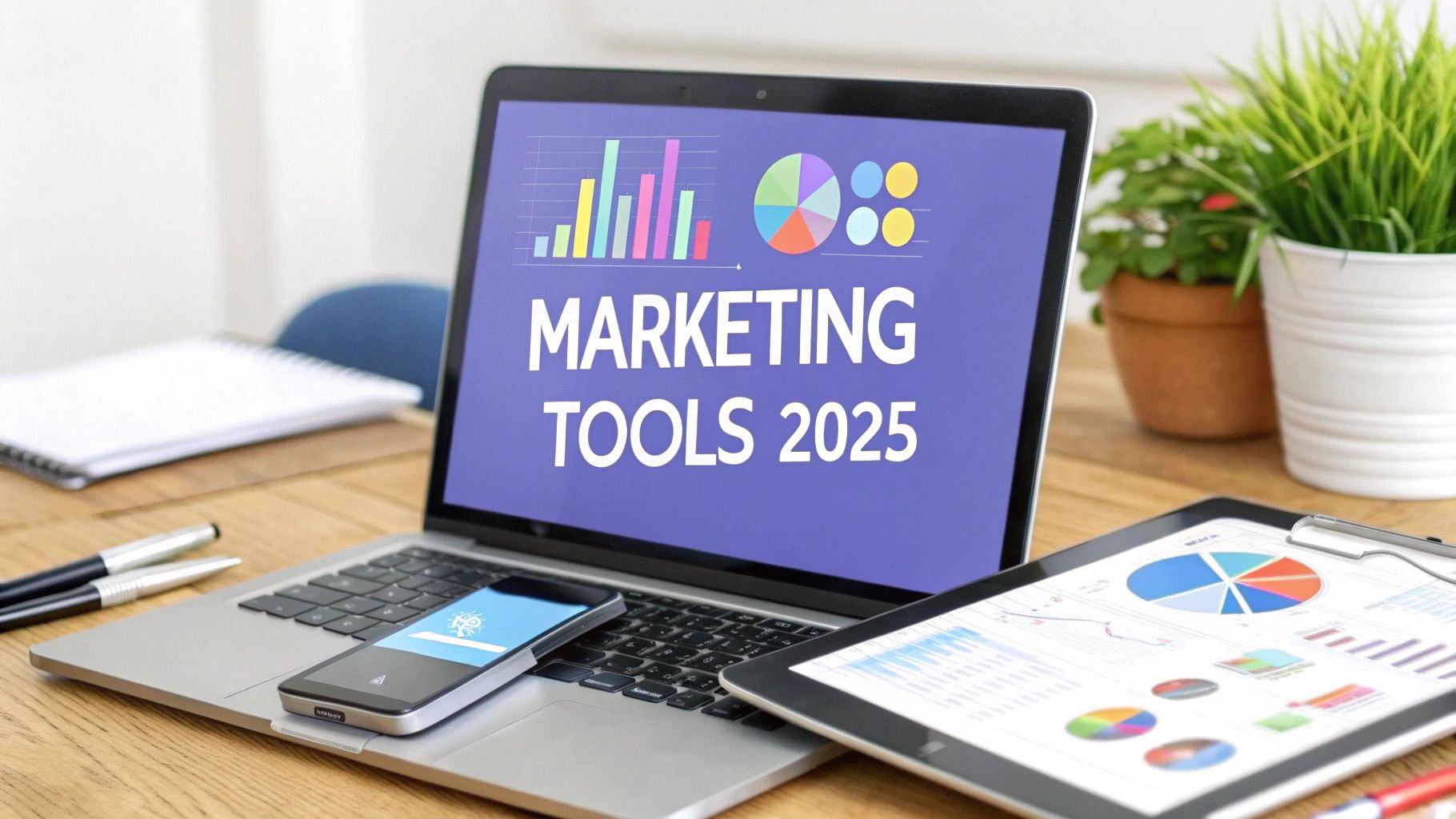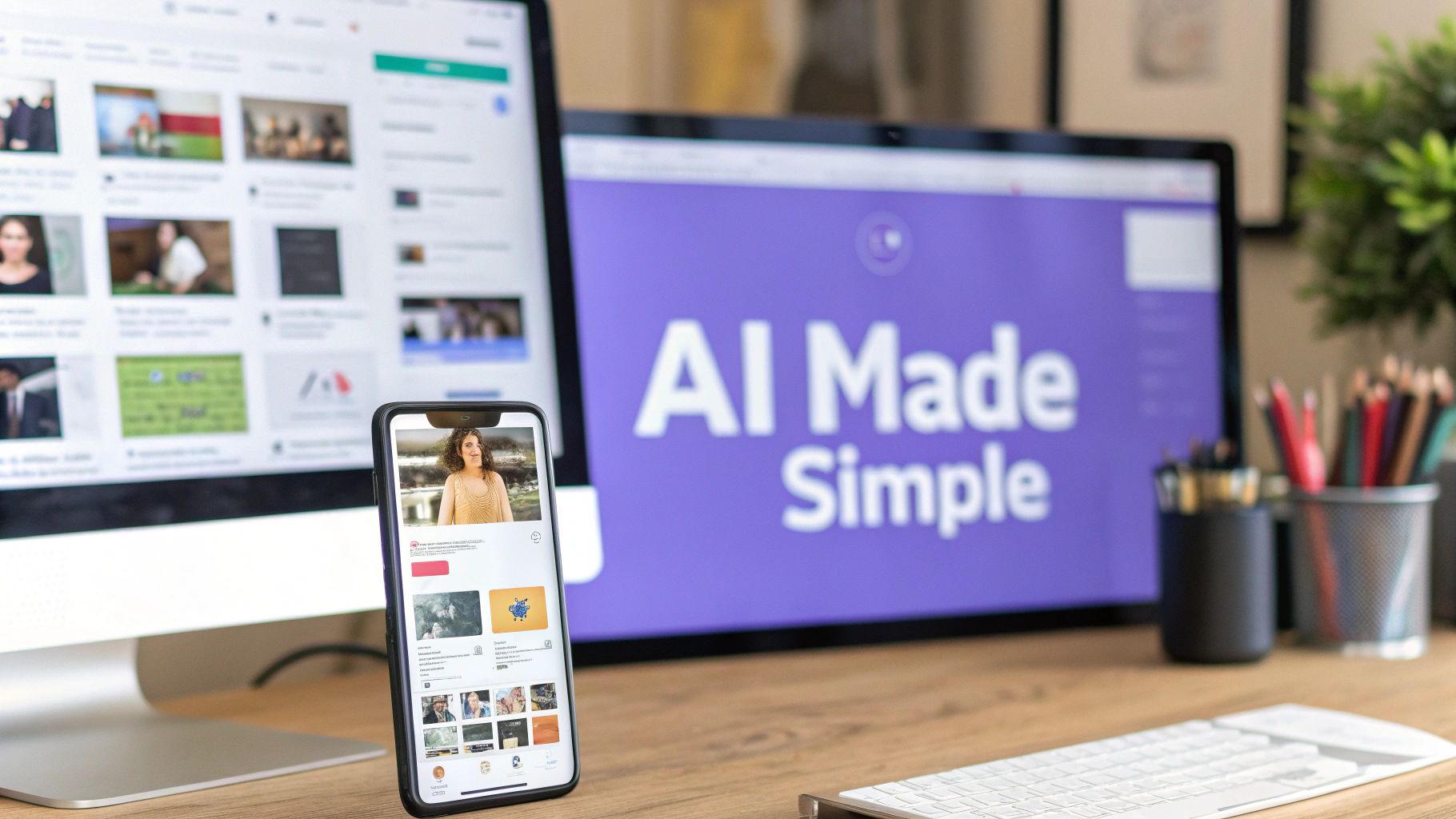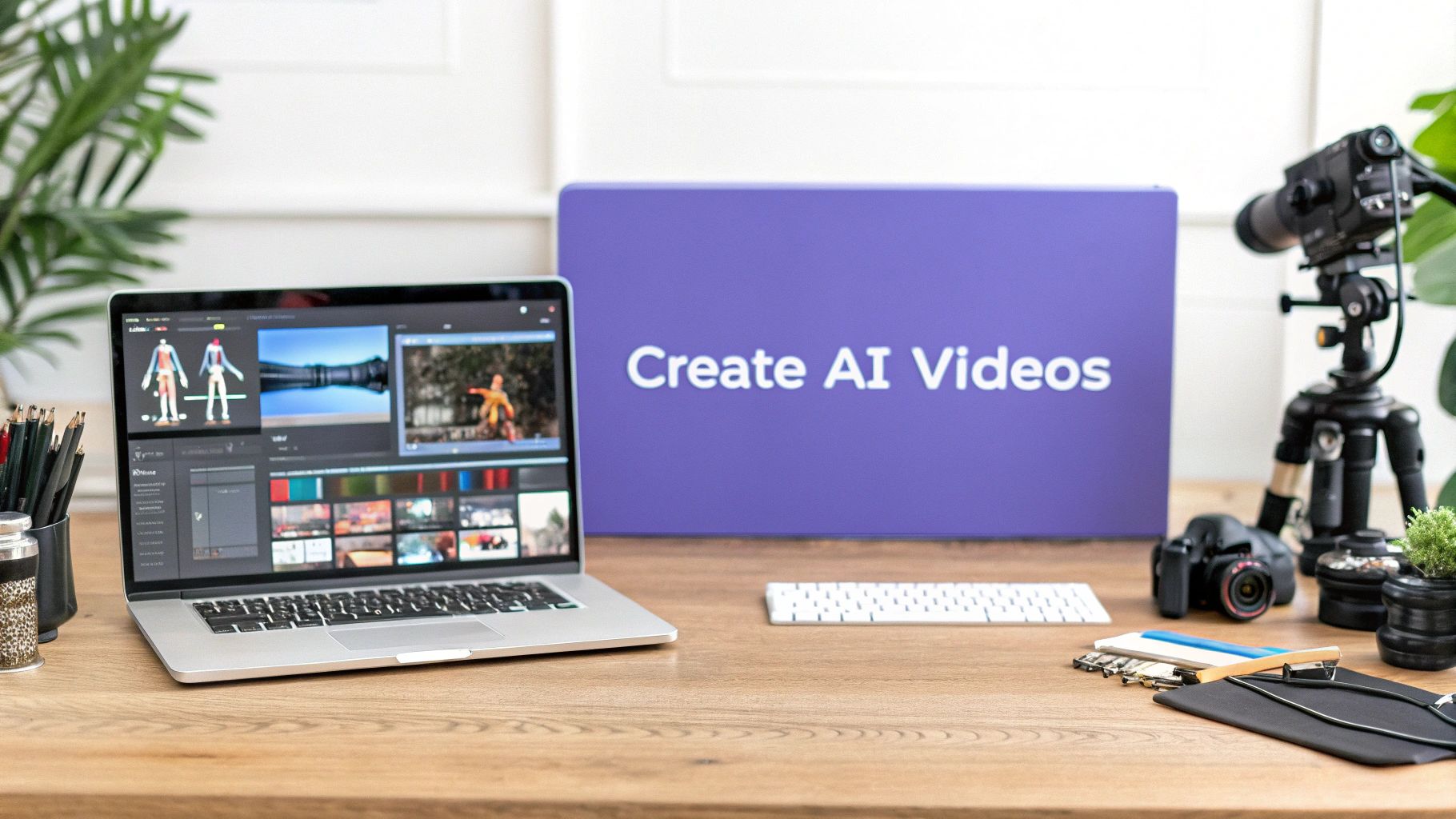So, what do we actually mean by AI social media content creation? It's really just the process of using smart tools to handle the heavy lifting of coming up with ideas, writing copy, making visuals, and even scheduling posts for platforms like Instagram, TikTok, and LinkedIn. It takes the old-school manual grind and makes it a much faster, more intelligent workflow, letting brands produce higher quality content at scale.
Why AI Is Reshaping Social Media Content
Let's cut through the noise—AI isn't some far-off concept; it's already a fundamental piece of any modern social media strategy. This isn't about robots taking over. It's about giving creators powerful tools to work smarter and reclaim their most precious resource: creative energy. From that first spark of an idea to filling out a whole month's content calendar, the entire process is being completely re-imagined.
We're seeing a massive shift away from slow, manual work toward an automated, data-driven system. This is a game-changer because it allows for more consistent, high-quality content that actually resonates with people. Think about it: instead of wasting hours fighting with design tools or agonizing over captions, you can pour that time into the strategy that truly grows your brand.
This infographic breaks down how social media pros are using AI to work smarter, not harder.
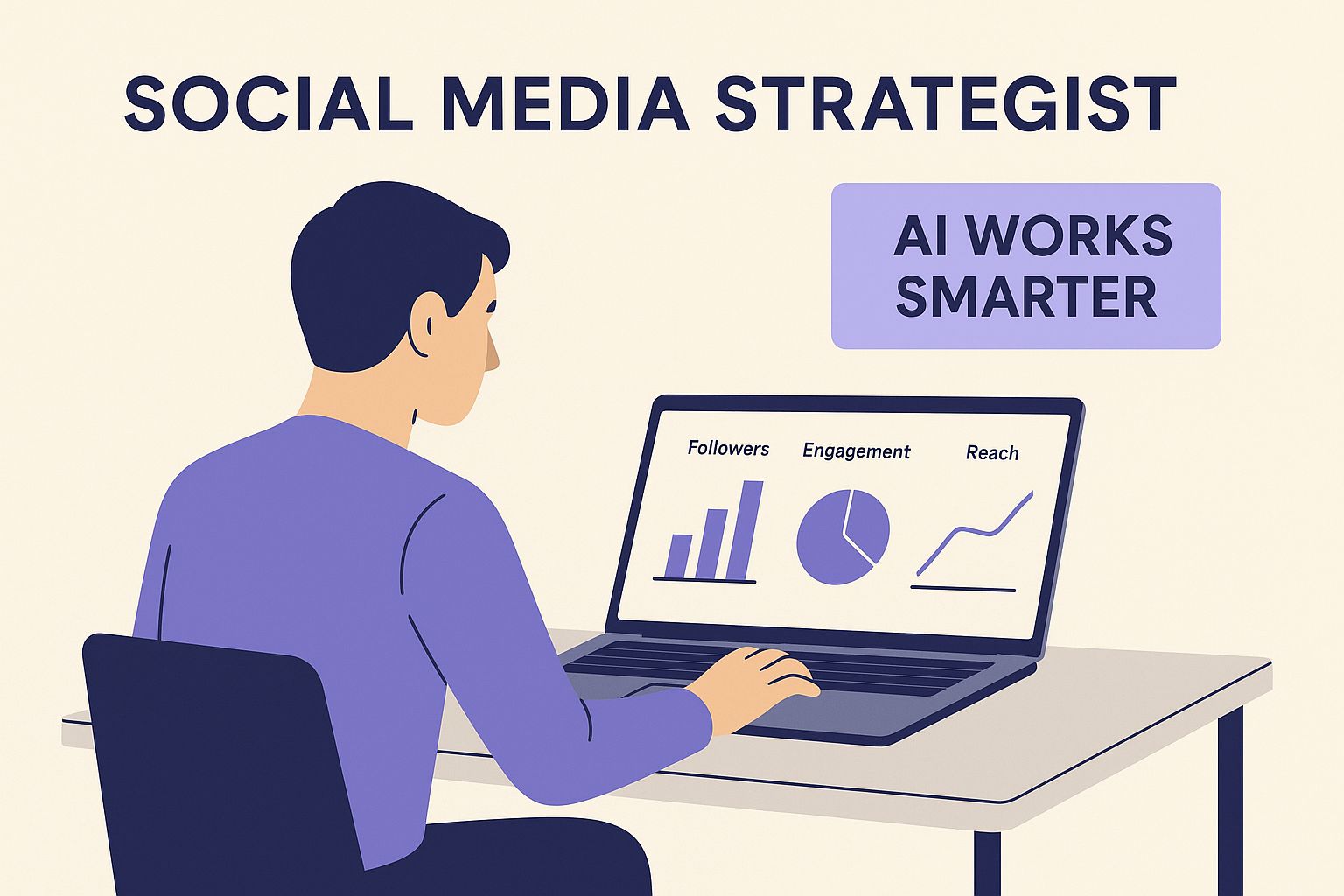
What the image really drives home is how we're moving from tedious tasks to strategic, data-backed decisions. That's the core benefit of bringing AI into your daily routine.
The New Content Creation Standard
The pressure to pump out fresh, engaging content never stops. It's no wonder, with the global social media audience projected to reach 5.45 billion people by 2025. With users spending an average of 2 hours and 24 minutes scrolling every day, the fight for their attention is intense.
This is exactly where AI steps in to become a necessity, not just a nice-to-have. The numbers don't lie: 60% of U.S. companies are already using generative AI to keep their social media feeds active around the clock. This isn't a fleeting trend; it’s a necessary adaptation to how the digital world works now.
AI does more than just speed things up. It adds a layer of intelligence that used to be out of reach for smaller operations. It can analyze performance data, spot trending topics, and even tell you the best times to post to get more eyes on your content.
This shift empowers even a one-person team to operate with the insight of a big agency. By taking over the repetitive, soul-crushing tasks, AI tools free you up to focus on big-picture strategy, community building, and all the other human touches that create a real, loyal audience.
To get a fuller picture of its applications, I'd suggest exploring the broader landscape of AI for content creation. This guide is all about giving you practical, hands-on advice, but it helps to first understand why this shift is so important before we dive into the how.
Finding Your Next Viral Idea with AI
We’ve all been there. Staring at a blank content calendar, the blinking cursor mocking you. That used to be the moment panic set in. Now, this is where AI social media content creation steps in, acting less like a tool and more like an inexhaustible brainstorming partner.
Forget asking an AI for a generic "content idea." The real power comes from getting specific. Treat your AI like a specialist you can direct with pinpoint accuracy, not a vague assistant.
Let's say you're a SaaS company. Instead of asking for "ideas," you could prompt ChatGPT with something like, "Generate 5 Instagram Reel ideas for a project management tool. The target audience is remote team leads struggling with deadline tracking. Focus on relatable, slightly humorous scenarios." The difference is night and day.

As you can see, a detailed prompt doesn't just give you a vague concept; it delivers ready-to-use content angles. This small shift in how you ask turns a simple tool into an idea-generating powerhouse.
Moving from Prompts to Full Content Plans
The real magic starts when you go beyond single ideas and begin building out entire content pillars. You can ask an AI to generate initial concepts and then immediately ask it to expand on the best ones, creating a whole web of related topics that can fill your calendar for weeks.
For example, take that prompt for the SaaS startup. Let's say one of the ideas is a poll about the "most annoying project management task." Great. Now, follow up with: "Based on 'missed deadline notifications' winning the poll, write three short video scripts showing our tool preventing this exact problem."
This back-and-forth process creates momentum. You’re turning one small, successful idea into a full-blown, multi-format content series. It's a strategic system, not a guessing game. It's a prime example of how AI can help us be more creative by handling the heavy lifting of ideation.
Using Data to Fuel Your Ideas
Modern AI tools aren’t just spitting out text; they can analyze trends and data. This gives your ideas a much stronger chance of hitting the mark right from the start. You can feed an AI your top-performing posts and ask it to find common threads or formats that your audience clearly loves.
This data-driven approach is why around 71% of social media marketers have already brought AI tools into their workflow. The aim is to create posts that feel more personal and genuinely connect.
Pro Tip: Don't just stop at the idea. For every concept you like, immediately ask your AI to generate five different hooks for it. A brilliant idea with a weak opening is dead on arrival in a fast-scrolling feed.
Getting the hook right is everything, especially for video. If you want to dive deeper, we have a whole guide on how to create attention-grabbing hooks with AI video tools.
AI Ideation vs. Traditional Brainstorming
When you put AI-powered ideation side-by-side with the old-school whiteboard session, the advantages become crystal clear. While a good team brainstorm still has its place, AI introduces speed and data-backed insights that are tough to match manually.
Here's a quick breakdown of how they compare.
| Attribute | AI-Powered Ideation | Traditional Brainstorming |
|---|---|---|
| Speed | Generates hundreds of ideas in seconds, letting you test and iterate incredibly fast. | Can be slow and really depends on the creative energy of the team on any given day. |
| Data Integration | Can analyze audience data and current trends to make suggestions more relevant. | Relies on team members' intuition and past experience, which can be biased or outdated. |
| Creative Output | Offers endless variations and can connect seemingly unrelated concepts for fresh angles. | Limited by the collective knowledge and perspectives of the people in the room. |
Using AI as your starting point doesn’t replace your creativity—it supercharges it. The AI handles the sheer volume of ideation, which frees you up to do what humans do best: refine the strongest concepts and add that unique, authentic touch. That partnership is where social media content is heading.
Writing Captions and Scripts That Actually Connect
A great idea is one thing, but turning it into copy that grabs someone mid-scroll? That’s the real work. It needs to sound human, not like a robot pieced it together. This is where you can really see the magic of using AI for social media—it becomes less about generating text and more like having a writing partner.
The secret isn't just telling an AI to "write a caption." You have to give it a solid creative brief. I always think of it like directing an actor. You wouldn't just say, "act sad." You'd give them backstory, motivation, and a scene to work with. The same goes for your AI prompts.
For instance, don't just give it a vague topic. Get specific. Try something like this: "Draft a script for a 30-second Instagram Reel. I need a hook that hits on the biggest headache for new homeowners: feeling totally swamped by repairs. Follow that with three super-simple tips for a DIY home maintenance checklist. End it with a question that gets people talking in the comments."
When you provide that kind of detail, you're not just using a text generator anymore. You've got a strategic partner. It gets the goal, the audience, and what you want people to do. The first draft it gives back is often 80% of the way there, which is a huge time-saver.
Getting the AI to Sound Like You
One of the biggest giveaways of AI copy is that it can feel a little… generic. The fix is to teach the AI your brand's unique personality. This isn't a set-it-and-forget-it task; it’s more of an ongoing conversation. I recommend creating a simple "Brand Voice" guide that you can feed to the AI as context for every single request.
So, what goes into this guide?
- Your Vibe: Are you witty, authoritative, empathetic, or playful? Jot down 3-5 words that capture your tone.
- Go-To Phrases: Got any taglines or recurring phrases? A coffee brand I know always calls its morning blend "rocket fuel." Put that in there.
- What to Avoid: List words or tones that are completely off-brand. A luxury travel company might say, "no slang or overly casual language."
- Formatting Quirks: Do you love emojis? Which ones? Do you write short, snappy sentences or longer, more descriptive ones?
Giving the AI this context upfront trains it to mimic your style, which drastically cuts down on your editing time. It starts to understand that you're the funny friend with great advice, not a stuffy encyclopedia.
My best advice is to make it a feedback loop. I'll have the AI generate a caption, then I'll tweak it until it’s perfect. After that, I copy my edited version and feed it right back to the AI, saying, "This is exactly the tone I want. See how the sentences are shorter and I used the fire emoji? Let's use this style for the next five captions."
This process is what makes all the difference. You're fine-tuning the AI's understanding, so every piece of content it helps you with gets better and better. You’re essentially building a personalized writing assistant that learns on the job.
Crafting Copy for Each Platform
Let's be real: what crushes it on LinkedIn will totally flop on TikTok. A massive benefit of using an AI tool is how quickly it can adapt a single idea for different channels, complete with the right formatting and tone.
Imagine you just published a new blog post. Instead of rewriting everything from scratch, you can fire off a few targeted prompts:
- For LinkedIn: "Pull the key takeaways from this article and turn them into a professional, thought-leadership post for LinkedIn. Use bullet points and end with a question for my network."
- For Instagram: "Create a great Instagram caption from this article. Find a surprising statistic to use as the hook, tell a quick story, and give me 3-5 relevant hashtags."
- For X (formerly Twitter): "Write a short, punchy tweet about this article. Frame it as a controversial take or a polarizing question to get a debate going. Keep it under 280 characters."
This strategy saves hours of tedious rewriting. The AI does the heavy lifting—changing the tone, length, and structure—so you can focus on adding that final human polish that makes a post feel like it truly belongs on that platform.
Creating Stunning Visuals with AI Tools
Let's be honest, amazing visuals are what stop people from scrolling past your content. For years, that meant shelling out for a designer or spending hours wrestling with complicated software. That's all changed. AI image and video generators have completely flipped the script, putting professional-grade visuals within everyone's reach. This isn't just about making pretty pictures; it's about taking the exact idea in your head and turning it into a real asset in a matter of seconds.
The secret sauce is learning how to "talk" to the AI through effective prompts. There’s a massive difference between asking for "a person at a desk" and getting specific with "a female founder in a sunlit loft office, looking thoughtfully at her laptop, cinematic style, warm tones, 4K." The first prompt gives you a generic stock photo. The second tells a story that actually connects with your brand.
For instance, this is what the Midjourney interface looks like. It’s where simple text prompts are transformed into incredibly detailed images.

Getting comfortable with an interface like this is a fundamental skill for anyone serious about AI social media content creation. It's the new canvas.
Crafting Prompts for Brand Consistency
The real magic happens when you use AI to create a consistent look and feel for your brand. You can actually direct the AI to use specific art styles, color palettes, and even camera angles. This ensures every single image feels like it belongs to you. That kind of control used to be reserved for campaigns with huge budgets.
Here are a few tricks I've learned for getting consistent results:
- Nail Down Your Style: Always include terms that define your look, like "minimalist line art," "vibrant photographic style," or "retro comic book aesthetic."
- Use Your Palette: Feed your brand colors right into the prompt. For example, add "...using a color palette of navy blue, burnt orange, and cream."
- Set the Mood: Words have power. Use descriptors like "serene and calming," "energetic and bold," or "professional and trustworthy" to guide the emotional tone of the final image.
By being this specific, you're essentially training the AI on your brand’s visual identity. Before you know it, you'll have a library of unique, on-brand assets that you own completely. This frees you from the endless cycle of paying for and searching through stock photo sites. If you want to explore more tools, take a look at our guide on the https://sprello.ai/blog/best-ai-tools-for-content-creators that are great for generating visuals.
Beyond Static Images: The Rise of AI Multimedia
Visuals aren't just still images anymore. AI tools can now whip up custom background music, generate surprisingly realistic voiceovers, and even create short video clips, all from a simple text prompt. This means high-quality multimedia production is no longer just for teams with deep pockets.
Think about it. You just generated a great series of images for a new product launch. Next, you can ask an AI to:
- Generate a voiceover: "Create a warm, confident female voiceover reading this script..."
- Compose background music: "Produce an upbeat, inspiring instrumental track for a 30-second social media ad."
- Animate the images: You can then bring everything into a platform like Sprello to turn those static pictures into a dynamic video, complete with motion, text overlays, and perfectly synced audio.
This approach brings your entire production workflow under one roof. You can move from a simple idea to a fully produced video ad in a tiny fraction of the time it used to take. This is quickly becoming the new industry standard.
By 2025, the AI influence on visual media will be impossible to ignore. Projections show that around 71% of images on social platforms will be AI-generated. This is a massive shift, driven by the accessibility of tools like DALL·E and Midjourney, and it's changing how we all create and consume content online.
This evolution is a game-changer. It means small businesses and solo creators can finally compete on a level playing field with bigger brands, producing content that looks and sounds incredible, grabs attention, and actually drives engagement.
How to Automate Your Content Schedule
Making great content is a huge win, but it's only half the story. If you post when your audience is offline, you've essentially shouted into the void. This is where smart scheduling stops being a simple convenience and becomes a core part of any real AI social media content creation plan. The dream is to set it and forget it, letting you think about the big picture instead of constantly watching the clock.
This is exactly what all-in-one AI platforms like Sprello are built for. Think of it as your command center. You can map out, build, and schedule a whole month's worth of content for Instagram, LinkedIn, X, and TikTok without ever jumping between tabs. This unified workflow tames the chaos of juggling different tools, calendars, and spreadsheets.
Let AI Find Your Perfect Post Times
One of the best things about modern scheduling tools is how they dig into your audience data. Instead of throwing darts at a calendar and hoping for the best, these platforms do the heavy lifting for you. They pinpoint the exact moments your followers are most active and ready to engage.
This data-first approach takes the guesswork completely out of the equation.
The AI might discover your LinkedIn crowd is most engaged on Tuesday at 10 AM, while your Instagram followers are deep in their feeds on Thursday evenings. It then serves up these prime-time slots as suggestions, giving every post its best shot at success right out of the gate.
This isn't just about clawing back a few hours in your day; it’s about making a bigger splash. When you post at peak times, your content gets an initial burst of engagement that algorithms love, which often translates to much better organic reach.
And it’s not a one-time thing. The AI is always learning from your performance, tweaking its recommendations as your audience's habits change over time.
A Real-World Campaign Scheduling Scenario
Let's say you just published a big, in-depth article on your blog. The old way would involve manually creating and posting about it across your channels for the next week. The new way? You build an entire automated campaign in just a few minutes.
Here’s what that could look like inside an all-in-one tool:
- LinkedIn Post: You queue up a sharp, professional summary of the article to post Monday morning, right when people are settling into their work week. The AI can even help you polish the caption to sound more authoritative.
- Instagram Reel: Next, you whip up a quick video highlighting the article's top 3 takeaways. Our guide on automated video creation walks through how easy this is. You schedule it for Wednesday evening, a prime time for casual scrolling.
- X (Twitter) Thread: Finally, you break down the article's main arguments into a five-tweet thread, adding some questions and relevant hashtags to get a conversation going. You can schedule this to roll out on Friday, spacing the tweets a few hours apart.
In just a few clicks, your whole promotion is planned, optimized, and ready to go. The AI handles the timing for each platform, so you don't have to. This kind of efficiency completely changes the game. It frees you from the drudgery of manual posting and gives you back the time to actually talk to your community and dream up your next great idea.
Keeping Your Content Human and Authentic
As we all get more comfortable with AI in our social media workflows, there's a question that keeps popping up: How do we stay authentic? It’s a valid concern. Automation is a game-changer, but nobody wants their brand's unique spark to get lost in the process.
Here’s how I’ve learned to think about it: AI isn't here to replace you. It’s your most valuable, tireless creative assistant.
Think of anything an AI tool gives you as a solid first draft. It’s the raw clay, ready for you to shape. Its job is to do the heavy lifting—structuring a script, brainstorming a dozen caption ideas, or pulling insights from audience data. Your job is to step in and add that final, irreplaceable human touch.
This is where you weave in your personal stories, your specific brand voice, and the genuine perspective that makes your content connect with people. AI can spot patterns and mimic styles, but it can’t fake lived experience or build a real community. That part is, and always will be, on you.
The AI-Human Partnership
Let's be real: keeping that authentic feel is non-negotiable, especially when consumer trust is so fragile. There are still hurdles to overcome in how people view automated content. For instance, recent survey data shows that 26% of consumers think AI-generated website copy feels impersonal, and 20% flat-out distrust AI-generated social posts. You can dig into more of these evolving social trends to get a better feel for the landscape.
But that data doesn’t mean you should ditch AI altogether. It just proves why a partnership approach is so critical.
- Let AI handle the grunt work. It can outline a video, suggest five different hooks, or build a data-backed content calendar in seconds.
- You bring the soul. You take that framework and inject your personality, your anecdotes, and your unique insights.
Imagine an AI generates a caption about "the benefits of morning routines." It'll be factually correct, but probably a bit generic. You can take that draft and add a quick, personal story about how your own morning routine went completely off the rails last Tuesday. Suddenly, the content is instantly more human and engaging.
The goal isn't to have AI create for you, but to create with you. It speeds up the process so you can spend more time on the parts that build a real connection with your audience.
Practical Tips for Authentic AI Content
To keep your content from feeling robotic, just treat every piece of AI-generated text or visuals as a jumping-off point. Your final review is where the magic really happens.
Before you hit publish, run through a quick mental checklist:
- Does this sound like me? Read it out loud. If it feels stiff or doesn't match your natural voice, tweak it until it does.
- Can I add a personal touch? Is there a specific example, a quick story, or an opinion you can drop in to make it uniquely yours?
- Is this actually helpful? AI is great at summarizing information, but you're the one who can add the nuanced advice that only comes from real-world experience.
By making this simple review a habit, you can ensure that even when using AI to help with your social media content, the final product is always stamped with your authentic brand identity.
Got Questions About AI Content Creation? We've Got Answers
Jumping into AI for your social media can feel like a big leap. It’s totally normal to have questions. After all, when a tool is this powerful, you want to know exactly what you’re getting into. Let’s tackle some of the most common things people ask.
Will AI Take Over a Social Media Manager's Job?
Not a chance. Think of AI as your super-efficient assistant or co-pilot, not the one flying the plane.
AI is brilliant at the heavy lifting—drafting captions, crunching performance numbers, and queuing up posts. It handles the repetitive stuff with a speed no human can match, which is a massive win for any team.
But what AI can't do is what truly matters: strategy, community building, and genuine human connection. It can't understand the subtle nuances of a customer's comment or make the big-picture decisions that define your brand. The real magic happens when you pair AI’s efficiency with a human’s creative vision and gut instinct.
I'm a Complete Beginner. Where Do I Even Start?
The trick is to keep it simple. Don't try to master everything at once.
A great starting point is just using an AI chat tool, like the one inside Sprello, for one single task: brainstorming. Forget about generating complex videos or images for now.
Just spend a week feeding it prompts for post ideas in your niche. See what it comes up with. This is a low-stakes way to get a feel for how to "talk" to the AI and see its value right away. Once you're comfortable with that, you can start exploring other things, like asking it to write a script based on one of your best ideas.
The secret to avoiding overwhelm is to master one part of the AI-powered workflow at a time. Trying to do everything at once is a recipe for frustration. Instead, build your skills incrementally, starting with the task that will save you the most time right now.
How Do I Make Sure My Content Doesn't Sound Like a Robot Wrote It?
This is the number one concern I hear, and thankfully, the fix is straightforward. It all comes down to your prompts and your willingness to edit.
First, always treat whatever the AI gives you as a first draft. It’s a starting point, not the finished product. Your job is to bring it to life by adding your brand's unique voice, personal stories, and specific details.
Second, get really descriptive with your prompts. Don't just say, "Write a caption." Instead, try something like, "Write a witty, slightly sarcastic caption about productivity hacks, channeling the voice of someone like Ryan Reynolds." Giving the AI a clear personality to mimic makes a world of difference and gets the draft 90% closer to what you actually want.
Ready to streamline your video creation process and produce high-converting content in minutes? Sprello gives you an all-in-one suite to go from idea to final export without the usual headaches. Start creating with Sprello today!
